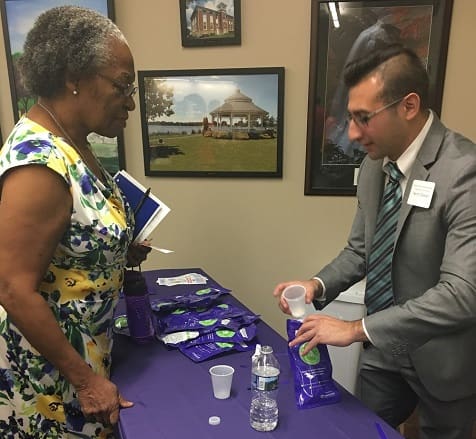
“Substance abuse addiction is a pipeline,” said Darryl Brake, Executive Director at Summit County Community Partnership in Stow, Ohio. “Prevention is at the front of the pipeline. Prevention needs to be emphasized to restrict people from entering the pipeline at all.”
Located in Ohio, the state with the highest heroin overdoses in the country, the coalition began in 1990 in the fourth highest populated county in the state. Inspired after attending a workshop at CADCA’s Mid-Year Training Institute, leaders at the Summit County Community Partnership focused their attention on drug disposal pouches.
“More than 80 percent of heroin addicts started with opioids,” said Brake. “We wanted to restrict access, hoping to restrict people who get into ‘the pipeline.’”
The coalition made calls to a sister coalition in Axe, Missouri and connected with Mallinckrodt Pharmaceuticals, who donated one year’s supply equivalent to 40,000 drug disposal pouches. The donation included 25,000 medium pouches, which can hold 45 pills or six ounces of liquid and 15,000 small pouches, which can hold approximately 15 pills.
The project launched on August 31st, 2016, International Overdose Awareness Day. The coalition held a press conference alongside health department leaders and project partner Acme Markets; the event was covered by local news and a radio station, who followed up with a four hour segment about the dangers of opioids. The coalition also took advantage of the DEA’s Drug Take Back Day in October 2016 and April 2017 to draw attention to the importance of proper drug disposal.
Forming another partnership, the coalition connected with Acme Markets, a local grocery store, who has 18 locations across the county with pharmacies inside. Acme Markets printed survey card with four questions, which would be attached to each pouch. The receiver of the pouch would merely have to fill out the questions related to the drug pouch content, location and their impressions of the project and mail it back to the coalition. A local clinic for people with mental conditions volunteered to help, assisting in tagging each of the 40,000 pouches with the survey cards.
Using the logic model and community assessment, the coalition devised the best methods of distribution among the community. Eighteen permanent sites were identified, including Acme Market pharmacies and hospital pharmacies, which would hand out a drug disposal pouch with each opioid prescription. EMTs were given disposal pouches to give out and instruct residents on proper use.
Senior citizens in the community provided a surprising obstacle – they were hesitant to get rid of their medication for fear that they couldn’t afford the deductible for new medications. After hosting a focus group, the coalition and seniors learned that stolen medicine was becoming a more prominent issue amongst the demographic. That knowledge encouraged the older community members to be more vigilant about proper disposal, which they could learn through the refrigerator magnet the coalition created and distributed.
After realizing that police officers would be unable to carry the drug disposal pouches due to the heavy volume that they were already tasked with carrying daily, the coalition pivoted and reached out to the Community Policing sector, who give public speeches and provide interactive teaching about drug identification and disposal. After partnering with the coalition, the Community Policing department handed out drug disposal pouches to attendees after seminars and training activities.
As the survey cards were mailed back, interesting discoveries were made. The communities with the highest overdose rates sent back the most cards – a positive note for the coalition, indicating that they were targeting the best areas of the county to attempt to stop opioid abuse.
Of the survey cards that were mailed back, the coalition found:
- 41 percent of the county used the bags for opioid/narcotics
- 23 percent for over-the-counter medications
- 23 percent for medicines other than opioids/narcotics
- 9 percent for vitamins
- 4 percent for medicines that were unidentifiable to the user
The project is currently nine months old and ongoing. Mallinckrodt Pharmaceuticals provided one year’s supply of drug disposal pouches and the coalition recently received a grant to continue their work. The response from the community has been positive.
“People have said it’s an excellent program, easy to use, easy to learn proper disposal and that they are glad to be a part of fighting this epidemic,” said Brake. “We’ve had a lot of success so far, but it’s important to start nimble and be ready to pivot.”

